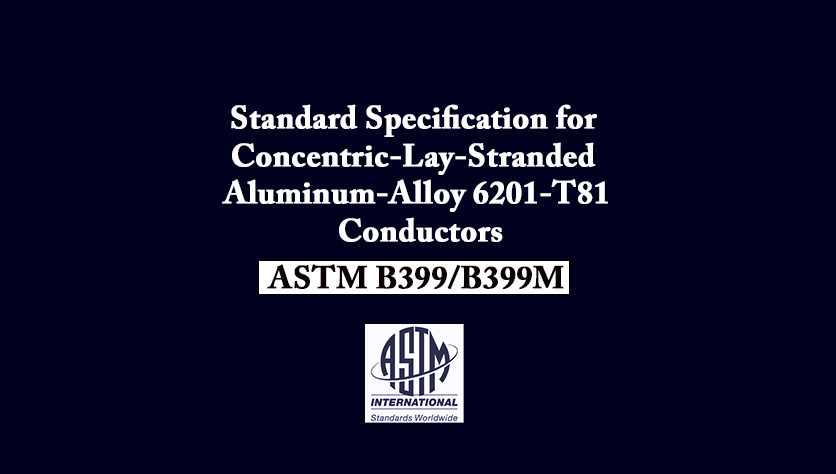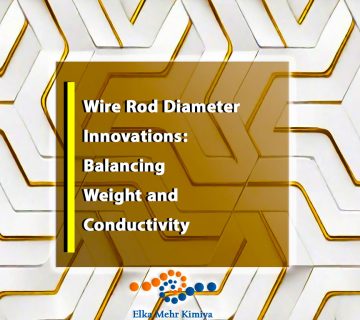Introduction
This article explores the ASTM B 399/B 399M standard, which specifies the requirements for concentric-lay-stranded conductors made from round aluminum-alloy 6201-T81 wires. These conductors are primarily used for electrical purposes, particularly in overhead lines and for conductors covered with weather-resistant materials. This comprehensive guide will delve into the classification, construction, properties, and applications of these conductors, providing detailed data tables for clarity.
Scope of ASTM B 399/B 399M
Classification
The ASTM B 399/B 399M standard classifies conductors into two primary classes:
- Class AA: For bare conductors usually used in overhead lines.
- Class A: For conductors to be covered with weather-resistant materials.
Key Requirements
The standard outlines several key requirements for these conductors, including:
- Construction requirements for various sizes and stranding configurations.
- Specifications for the materials used, including the aluminum-alloy wire.
- Guidelines for the permissible joints in the wires.
- Preferred lay and direction of the wires in the conductor.
- Rated strength and testing procedures.
Construction Requirements
The construction requirements for concentric-lay-stranded aluminum-alloy 6201 conductors are detailed in several tables within the standard. Below are comprehensive tables that include every size and specification mentioned in the document.
Table 1: Construction Requirements of Concentric-Lay-Stranded Aluminum-Alloy 6201 Conductors Sized to Have Diameter Equal to ACSR, Class AA and Class A
| Conductor Size Code Words | Approximate Aluminum 1350 Size Having Equivalent Resistance | Size and Stranding of ACSR with Equal Diameter | Required Construction | Mass per 1000 ft (lb) | Mass per km (kg) | Rated Strength (kips) | Rated Strength (kN) |
|---|---|---|---|---|---|---|---|
| 1,439,200 cmil | 729.2 mm² | 1,272,000 cmil | 54/7 Stranding, 61 Wires, 0.1536 in Diameter | 1,342 | 1,997 | 46.8 | 208 |
| 1,348,800 cmil | 683.4 mm² | 1,192,500 cmil | 54/7 Stranding, 61 Wires, 0.1487 in Diameter | 1,258 | 1,872 | 43.9 | 195 |
| 1,259,600 cmil | 638.2 mm² | 1,113,000 cmil | 54/7 Stranding, 61 Wires, 0.1437 in Diameter | 1,175 | 1,748 | 41.0 | 182 |
| 1,165,100 cmil | 590.3 mm² | 1,033,500 cmil | 54/7 Stranding, 61 Wires, 0.1382 in Diameter | 1,086 | 1,617 | 37.9 | 169 |
| 1,077,400 cmil | 545.9 mm² | 954,000 cmil | 54/7 Stranding, 61 Wires, 0.1329 in Diameter | 1,005 | 1,495 | 35.0 | 156 |
| 927,200 cmil | 469.8 mm² | 795,000 cmil | 26/7 Stranding, 37 Wires, 0.1583 in Diameter | 864.6 | 1,287 | 30.5 | 136 |
| 740,800 cmil | 375.4 mm² | 636,000 cmil | 26/7 Stranding, 37 Wires, 0.1415 in Diameter | 690.8 | 1,028 | 24.4 | 108 |
| 652,400 cmil | 330.6 mm² | 556,500 cmil | 26/7 Stranding, 19 Wires, 0.1853 in Diameter | 608.3 | 905.2 | 21.9 | 97.5 |
| 559,500 cmil | 283.5 mm² | 477,000 cmil | 26/7 Stranding, 19 Wires, 0.1716 in Diameter | 521.7 | 776.3 | 18.8 | 83.6 |
| 465,400 cmil | 235.8 mm² | 397,500 cmil | 26/7 Stranding, 19 Wires, 0.1565 in Diameter | 433.9 | 645.7 | 15.6 | 69.6 |
| 394,500 cmil | 199.9 mm² | 336,400 cmil | 26/7 Stranding, 19 Wires, 0.1441 in Diameter | 367.9 | 547.4 | 13.3 | 59.0 |
| 312,800 cmil | 158.5 mm² | 266,800 cmil | 26/7 Stranding, 19 Wires, 0.1283 in Diameter | 291.6 | 434.0 | 10.5 | 46.7 |
| 246,900 cmil | 125.1 mm² | 211,600 cmil | 6/1 Stranding, 7 Wires, 0.1878 in Diameter | 230.2 | 342.6 | 8.56 | 38.1 |
| 195,700 cmil | 99.2 mm² | 167,800 cmil | 6/1 Stranding, 7 Wires, 0.1672 in Diameter | 182.5 | 271.5 | 6.79 | 30.2 |
| 155,400 cmil | 78.7 mm² | 133,100 cmil | 6/1 Stranding, 7 Wires, 0.1490 in Diameter | 144.9 | 215.6 | 5.39 | 24.0 |
| 123,300 cmil | 62.5 mm² | 105,600 cmil | 6/1 Stranding, 7 Wires, 0.1327 in Diameter | 114.9 | 171.0 | 4.27 | 19.0 |
| 77,470 cmil | 39.3 mm² | 66,360 cmil | 6/1 Stranding, 7 Wires, 0.1052 in Diameter | 72.24 | 107.5 | 2.80 | 12.5 |
| 48,690 cmil | 24.7 mm² | 41,740 cmil | 6/1 Stranding, 7 Wires, 0.0834 in Diameter | 45.40 | 67.56 | 1.76 | 7.84 |
| 30,580 cmil | 15.5 mm² | 26,240 cmil | 6/1 Stranding, 7 Wires, 0.0661 in Diameter | 28.52 | 42.44 | 1.11 | 4.92 |
Table 2: Construction Requirements of Concentric-Lay-Stranded Aluminum-Alloy 6201 Conductors Sized by Standard Areas, Class AA and Class A
| Conductor Size | Required Construction | Mass per 1000 ft (lb) | Mass per km (kg) | Rated Strength (kips) | Rated Strength (kN) |
|---|---|---|---|---|---|
| 1,750,000 cmil | 61 Wires, 0.1694 in Diameter | 1,632 | 2,429 | 56.9 | 253 |
| 1,500,000 cmil | 61 Wires, 0.1568 in Diameter | 1,399 | 2,081 | 48.8 | 217 |
| 1,250,000 cmil | 61 Wires, 0.1431 in Diameter | 1,165 | 1,733 | 40.6 | 180 |
| 1,000,000 cmil | 37 Wires, 0.1644 in Diameter | 932.5 | 1,388 | 32.9 | 146 |
| 900,000 cmil | 37 Wires, 0.1560 in Diameter | 839.7 | 1,249 | 29.6 | 132 |
| 800,000 cmil | 37 Wires, 0.1470 in Diameter | 745.6 | 1,109 | 26.3 | 117 |
| 750,000 cmil | 37 Wires, 0.1424 in Diameter | 699.6 | 1,041 | 24.7 | 110 |
| 700,000 cmil | 37 Wires, 0.1375 in Diameter | 652.3 | 970.6 | 23.0 | 102 |
| 650,000 cmil | 37 Wires, 0.1325 in Diameter | 605.7 | 901.5 | 21.3 | 94.6 |
| 600,000 cmil | 19 Wires, 0.1724 in Diameter | 556.4 | 828.1 | 18.5 | 82.2 |
| 550,000 cmil | 19 Wires, 0.1658 in Diameter | 510.2 | 759.6 | 16.9 | 75.1 |
| 500,000 cmil | 19 Wires, 0.1586 in Diameter | 463.2 | 689.4 | 15.4 | 68.4 |
| 450,000 cmil | 19 Wires, 0.1507 in Diameter | 416.3 | 619.6 | 13.8 | 61.4 |
| 400,000 cmil | 19 Wires, 0.1422 in Diameter | 369.4 | 549.8 | 12.3 | 54.6 |
| 350,000 cmil | 19 Wires, 0.1328 in Diameter | 322.4 | 480.0 | 10.8 | 47.9 |
| 300,000 cmil | 19 Wires, 0.1230 in Diameter | 276.7 | 411.7 | 9.30 | 41.4 |
| 250,000 cmil | 19 Wires, 0.1128 in Diameter | 231.0 | 343.4 | 7.78 | 34.6 |
| 200,000 cmil | 19 Wires, 0.1020 in Diameter | 185.2 | 275.1 | 6.25 | 27.8 |
| 150,000 cmil | 19 Wires, 0.0904 in Diameter | 139.5 | 206.8 | 4.73 | 21.0 |
| 100,000 cmil | 19 Wires, 0.0776 in Diameter | 93.78 | 138.9 | 3.20 | 14.2 |
| 50,000 cmil | 7 Wires, 0.0894 in Diameter | 46.82 | 69.39 | 1.81 | 8.05 |
| 30,000 cmil | 7 Wires, 0.0733 in Diameter | 27.93 | 41.36 | 1.21 | 5.37 |
| 20,000 cmil | 7 Wires, 0.0636 in Diameter | 18.62 | 27.58 | 0.85 | 3.78 |
Application and Usage
The concentric-lay-stranded aluminum-alloy 6201 conductors specified under ASTM B 399/B 399M are designed for use in electrical transmission and distribution systems. They are particularly suited for:
- Overhead power lines: Due to their high strength and conductivity, they are ideal for long-span installations.
- Weather-resistant applications: The Class A conductors are designed to be covered with weather-resistant materials, making them suitable for harsh environmental conditions.
Standard Specification for Concentric-Lay-Stranded Aluminum-Alloy 6201-T81 Conductors [ASTM B399/B399M] Document:
Conclusion
The ASTM B 399/B 399M standard ensures the quality and reliability of concentric-lay-stranded aluminum-alloy 6201 conductors, providing detailed specifications for their construction and performance. By adhering to these standards, manufacturers and engineers can ensure the safe and efficient operation of electrical transmission and distribution systems.
















No comment